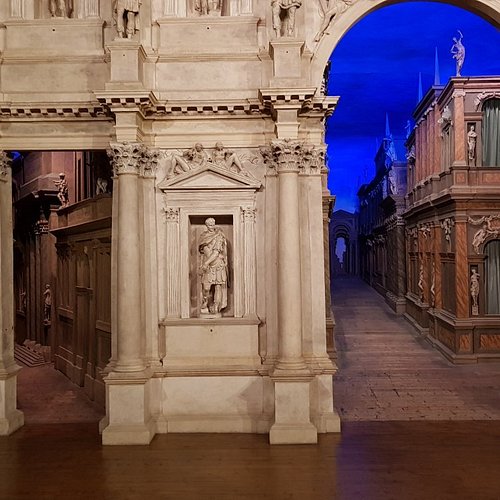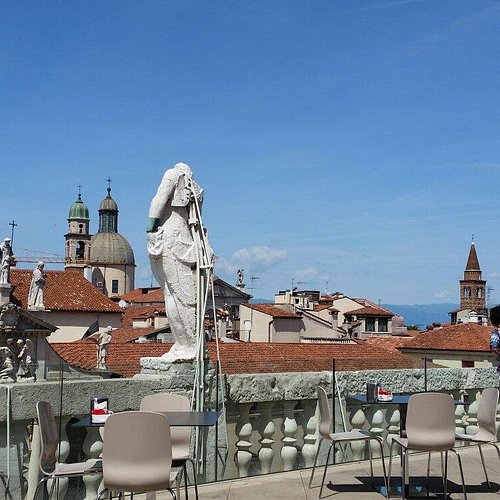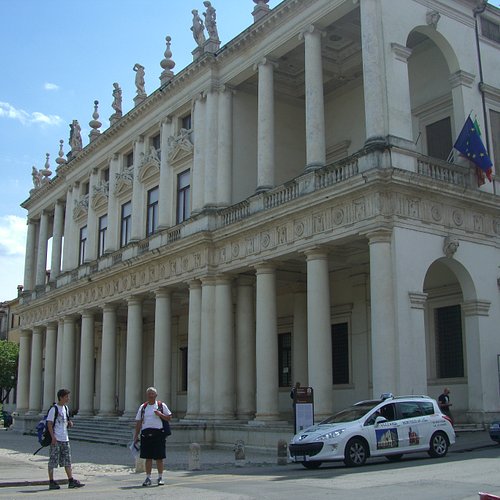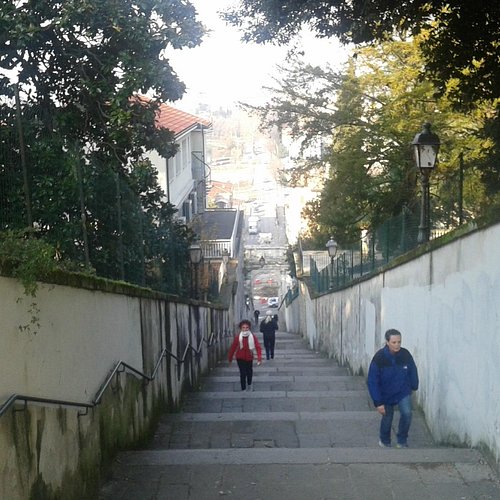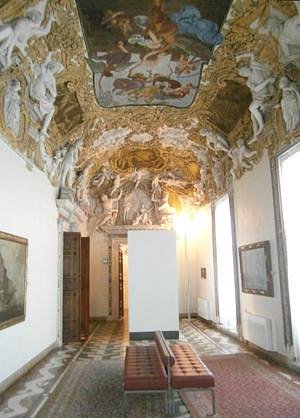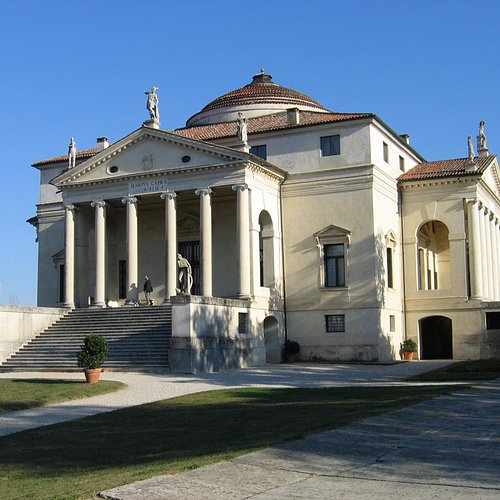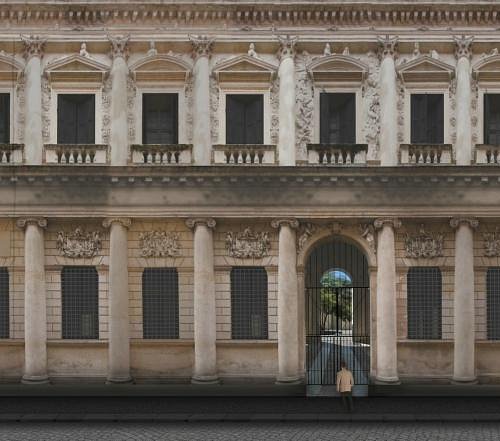What to do and see in Vicenza, Veneto: The Best Things to do
Vicenza’s history dates back to pre-Roman times, but it’s a Renaissance figure, Andrea Palladio, with whom the city is most associated. One of the preeminent figures in Western architecture, Palladio built more than twenty buildings here, including the Basilica Palladiana, the Palazzo Chiericati (home to Vicenza’s museum and art gallery), the Teatro Olimpico (his last and some say greatest work) and many other palaces and villas, leading UNESCO to designate the city as a World Heritage Site.
Restaurants in Vicenza
1. Teatro Olimpico
Overall Ratings
5.0 based on 2,882 reviews
Andrea Palladio’s last work and masterpiece, the Olympic Theatre was commissioned in February 1580 by the Accademia Olimpica, a society of mixed social classes founded in Vicenza in 1555 for cultural and scientific purposes and to which Palladio himself belonged. Construction began in May 1580, but Palladio died suddenly on 19 August of that year so did not see its completion. After various, complex delays, the theatre was completed five years later and opened on 3 March 1585 with the memorable staging of Sophocles’ Oedipus Tyrannus. The theatre is reached by way of the odeon and anti-odeon, two large rooms designed by Vincenzo Scamozzi and decorated respectively with frescoes by Francesco Maffei portraying divinities and allegorical figures (c. 1637) and a monochrome frieze of considerable documentary interest (c. 1595). This depicts theatrical productions presented by the Accademia before construction of the Olimpic Theatre (Amor costante, Sophonisba) and shows or events held in the new theatre (Oedipus the King, the diplomatic mission of Japanese envoys). Palladio designed a monumental scenae frons within an enclosed space intended to simulate classical theatres in the open air. It is flanked by two wings or stage doors and a semi-elliptical cavea with thirteen tiers, ending in a columned exedra at the top, partly open and partly with niches in the wall. Statues of the academicians who commissioned the theatre, dressed in classical costume, occupy the niches and plinths of the structure. A series of splendid bas reliefs showing stories of Hercules by Ruggero Bascape occupies the highest row. Wooden perspective scenery of the streets of Thebes runs back from the three openings in the scenea frons. This was designed by Scamozzi for the opening performance of Oedipus Tyrannus and has remained as a permanent feature
Reviewed By davida732 - Crewe, United Kingdom
The main reason for our visit after making a promise to ourselves to visit here if we ever had the chance after watching John Malkovich in Ripley's Game a couple of years ago where the closing scene was filmed here. It really is awe inspiring and we were very lucky to see a light show highlighting the stage and surroundings. We really need to return to watch a performance here one day
2. Basilica Palladiana
Overall Ratings
4.5 based on 2,165 reviews
The Palladian Basilica is a public building facing onto the Piazza dei Signori. Its name is linked to Andrea Palladio, who redesigned it, adding the famous loggias with serliana openings in white marble to the existing Gothic building. The building on which Palladio worked was the Palazzo della Ragione, built in Gothic style in the mid-fifteenth century. The upper floor is entirely taken up by an enormous hall with no intermediate supports, where the Council of the Four Hundred met. The copper-lined, inverted ship’s-hull roof was inspired by that of the Palazzo della Ragione in Padua. The Gothic facade was originally clad with diamonds of red and straw yellow Verona marble, which are still visible behind Palladio’s addition. A loggia surrounding the building was commissioned after its completion, but continually delayed due to various structural difficulties and the nature of the ground beneath. At the beginning of the sixteenth century the double order of porticoes and loggias, though not complete, collapsed. The Council called on many leading architects of the time to resolve the difficult problem of its reconstruction. They included Jacopo Sansovino, Sebastiano Serlio and Giulio Romano. The project was awarded to Andrea Palladio (1508-80) in 1549, following a competition, and he worked on it for the rest of his life. It was completed posthumously in 1614. The reconstructed building was called a basilica by Palladio himself, who had been inspired by the model of the Roman basilica for civic use. The building has three independent exhibition spaces that are used to host architecture and art exhibitions of international renown.
Reviewed By peterbysea
A vast structure filling the piazza. The upper hall with the wooden roof of an upturned boats hull is amazing. The view from the external galleries is pleasent over the market place. Sadly in winter the upper roof area is closed for H&S reasons! Take the lift up!
3. Piazza dei Signori
Overall Ratings
4.5 based on 1,715 reviews
Reviewed By TBBTGrace - San Francisco, United States
Piazza dei Signori (Square of the Lords) is the main square of this little gem of a town, Vicenza. During the Roman Empire it was the center of markets and exchange of commercial business, as well as one the main strolling areas of the citizenship.
4. Palazzo Chiericati
Overall Ratings
4.5 based on 553 reviews
The Palazzo Chiericati has been the historic home of the Civic Museum since 1855 and now houses the city's collections of paintings, sculptures and applied arts from the thirteenth to the twentieth centuries. A masterpiece of Palladio's early maturity (1550), the building not only has decorations from that period but also holds important documents on Vicenza's art history. The Museum of Palazzo Chiericati reopened the Palladian wing on December 2013, after the restoration works. On the main floor, the visitor can enjoy the works of the sixteenth and seventeenth centuries, contemporary to the construction of the building. The attic hosts the Bequest of Marquis Giuseppe Roi: his personal collection of paintings, drawings and engravings from the fifteenth to the twentieth century, set in a charming display of house-museum. On the ground floor the visitor can admire, in a temporary exhibition, a selection of masterpieces of the collection not currently on display: Paolo Veneziano, Memling, Montagna, Fogolino, Sansovino, Tintoretto, Maffei and Pittoni. In the basement are located the works donated to the museum by the sculptor Nereo Quagliato.
Reviewed By christina_stilista - Perth, Australia
Very beautiful museum and Palazzo that is worth the visit. Beautiful collection of art in addition to the Palazzo. There is an antique toy exhibit in the basement that is EXCEPTIONAL. I have never seen better anywhere in the world. I suggest you include this Palazzo in your visit to the Teatro Olimpico.
5. Santuario della Madonna di Monte Berico
Overall Ratings
4.5 based on 743 reviews
Reviewed By larryrosen99 - Wayne, United States
The sanctuary is situated at the top of a hill overlooking Vicenza. It can be reached by car or on foot. It’s a 20-25 minute walk from the old city, up a fairly steep hill, with sidewalks on both sides on both sides of the road. Visitors are rewarded with panoramic views of the city with jagged mountain peaks in the distance. The sanctuary is white and is adjoined by a well-proportioned brick clock tower. This is a beautiful spot!
6. Gallerie di Palazzo Leoni Montanari
Overall Ratings
4.5 based on 309 reviews
Reviewed By r0landbrunner - Zurich, Switzerland
there are some really excellent pieces to be seen here in the permanent collection, and there was a very good temporary exhibition at our visit about time. definitely worth the visit.
7. Villa Valmarana ai Nani
Overall Ratings
4.5 based on 701 reviews
Venetian villa with superb frescoes of the most important Venetian painters of 18th century: Giambattista and Giandomenico Tiepolo. Still owned and inhabited by the Valmarana family, who bought it back in 1720. Open to the public for visits 7 days a week and available for events such as weddings, conferences, gala dinners, photo shooting, business presentations, concerts, representations, etc
Reviewed By Clinor - Canterbury, United Kingdom
If you are in Vicenza, it is very well worth making the effort to get to the Villa ‘ai Nani’, which is a charming Villa in its own right and has interior frescoes by Gianbattista Tiepolo following his decoration of the grand staircase at the Wurzburg Residence, Germany) and his son Giandomenico. This is my third visit to the Villa, and each time I never fail to be enchanted by the light airy frescoes of the Villa Pavilion. All the frescoes of the Pavillion have a classical theme. In my view the most outstanding ones are in the entrance room but there are four further rooms each with a different narrative. In the room of Aeneas, there is a photograph of the Pavilion after the bombing of Vicenza in 1944. It is truly shocking. Some of the ceiling frescoes do not survive or only in part. It would be good to have more information available about the restoration; it must have been a real labour of love. We walked around the gardens before returning to the Foresteria where we had bought our tickets. There you can see a series of painted rooms, some of which were painted by the Tiepolo father and son. They make an interesting counterpoint to the more noble themes of the Pavilion.
8. Chiesa di Santa Corona
Overall Ratings
4.5 based on 500 reviews
The Dominican church was built in 1261 to house the relic of the Holy Thorn donated by Louis IX, king of France, to the bishop of Vicenza, the Blessed Bartolomeo da Breganze. The Gothic interior, with chancel by Lorenzo da Bologna from the second half of the fifteenth century, houses many important paintings and sculptural works. These include Giovanni Bellini’s masterpiece “The Baptism of Christ”, in the Garzadori altar, attributed to Rocco da Vicenza, and the “Adoration of the Magi” by Paolo Veronese. There is also a “Madonna of the Stars”, by Lorenzo Veneziano and Marcello Fogolino, a "Magdalen and Saints" by Bartolomeo Montagna and a “Virgin, Child and Saints” by Giambattista Pittoni. The apse is furnished with a fine wooden choir, carved and inlaid by Pier Antonio dell’Abate. The frescoes by Michelino da Besozzo in the Thiene Chapel are among the earliest decorations, dating from the early fifteenth century and offering a mature example of the International Gothic style.
Reviewed By 760billa - Spring Lake, United States
Chiesa di Santa Corona is a beautiful Dominican church located in the heart of Vicenza. It’s brick facade is unassuming and its gothic interior exudes understated elegance. Look for the many hidden treasures inside including Bellini’s “The Baptism of Christ” and the stunning Valmarania Chapel designed by Andrea Palladio.
9. Villa La Rotonda by Andrea Palladio
Overall Ratings
4.0 based on 1,067 reviews
“Maybe never architectural art has reached such a level of magnificence” (J. W. Goethe, after the visit at La Rotonda) La Rotonda is not a villa. It’s something more. In time it has been visited by poets and artists, sovereigns and statesmen, scholars and art amateurs, travellers and tourists. To everyone La Rotonda has given an unforgettable emotion, that sense of harmony and grace whose answer is a smile, a silence. After 500 years, La Rotonda today is still a place of pure beauty, waiting to give inspiration, culture, joy.
Reviewed By SisterKathryn - Turner, United States
Beautiful example Andrea Palladio architecture. Well worth a visit. We took a cab from downtown Vicenza, when we were ready to head back to town the helpful guard called a return taxi for us.
10. Palladio Museum
Overall Ratings
4.0 based on 283 reviews
a museum-workshop: this new kind of museum features not only works of art but also the experts who describe them.a museum in movement: having installed the hardware (a system of dynamic lighting for the spaces, video projection systems, showcases, etc), each year the software will change, i.e. the contents, according to the state of progress in studies and research.a marvellous building: one of Palladio's finest palaces and the only one that he saw completed both as regards the architecture and decorations (causing the ruin of the patron, Montano Barbarano).an intellectual challenge: to take specialist knowledge out of the ivory tower and communicate it to a wider public in the museum and on the web.a far from impossible mission: recounting architecture to non-architects, not as a history of buildings but of the people who designed, built and communicated them; and showcasing architectural drawings, the tools that body forth ideas, alongside models, photographs and videos.the beginning of a journey: to explore Palladio's buildings in Vicenza (associated with the Palladio Museum thanks to the combined ticket "Vicenza città bellissima") and his villas in the Veneto countryside.a crossroads: a place where institutions and scholars from various parts of the world work together and present joint projects.
Reviewed By AllanJGJ - Wellington, New Zealand
If you want to get a good understanding of what Palladio is about before visiting some of his buildings in Vicenza then this is the place to start your visit to the city. It's an innovative and brilliantly curated little museum in a building the lad designed himself. It focuses on his designs as well as his life and has some excellent scale models and cutaways as well as video projections of experts talking on his work. And don't forget to look up - while any original wall decorations are long gone the ceilings are pretty much intact in every room.

